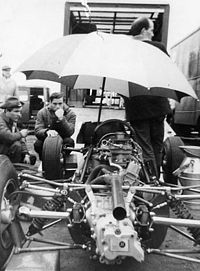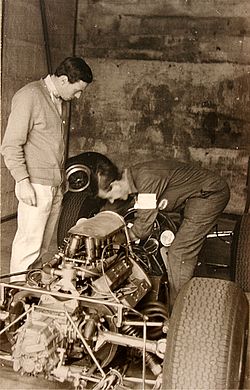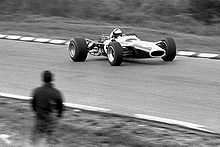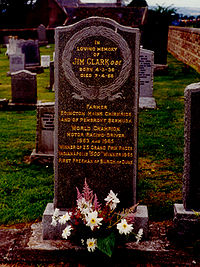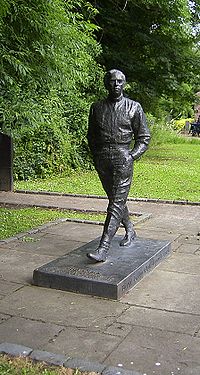- Jim Clark
-
For other people of the same name, see James Clark (disambiguation).
Jim Clark 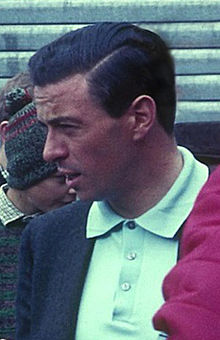
Clark in 1966Born 4 March 1936 Died 7 April 1968 (aged 32) Formula One World Championship career Nationality  British
BritishActive years 1960 - 1968 Teams Lotus Races 73 (72 starts) Championships 2 (1963, 1965) Wins 25 Podiums 32 Career points 255 (274)[1] Pole positions 33 Fastest laps 28 First race 1960 Dutch Grand Prix First win 1962 Belgian Grand Prix Last win 1968 South African Grand Prix Last race 1968 South African Grand Prix James "Jim" (or "Jimmy") Clark, Jr OBE (4 March 1936 – 7 April 1968) was a British Formula One racing driver from Scotland, who won two World Championships, in 1963 and 1965.
Clark was a versatile driver who competed in sports cars, touring cars and in the Indianapolis 500, which he won in 1965. He was particularly associated with the Lotus marque.
He was killed in a Formula Two motor racing accident in Hockenheim, Germany in 1968. At the time of his death, he had won more Grand Prix races (25) and achieved more Grand Prix pole positions (33) than any other driver. The Times recently placed Clark at the top of a list of the greatest Formula One drivers.[2]
Contents
Early years
James Clark Jr was born into a farming family at Kilmany House Farm, Fife, the youngest child of five, and the only boy. In 1942 the family moved to Edington Mains Farm, near Duns, Berwickshire, in the Borders. He was educated at primary schools, first in Kilmany and then in Chirnside, and then following three years of preparatory schooling at Clifton Hall near Edinburgh he was sent to Loretto School in Musselburgh, near Edinburgh.
Although his parents were opposed to the idea, Clark started his racing in local road rally and hill climb events driving his own Sunbeam-Talbot, and proved a fearsome competitor right from the start. On 16 June 1956, in his very first event, he was behind the wheel of a DKW sonderklasse at Crimond, Scotland. By 1958, Clark was driving for the local Border Reivers team, racing Jaguar D-types and Porsches in national events, and winning 18 races.
Then on Boxing Day 1958, Clark raced against the man who would launch him to superstardom. Driving a Lotus Elite, he finished second to Colin Chapman in a 10-lap GT race at Brands Hatch.[3] In 1959 he drove a Lotus Elite, finishing tenth at Le Mans partnered with John Whitmore, and the ex-Bruce Halford Lister Jaguar, winning the Bo'ness Hill Climb.[4] Chapman was sufficiently impressed to give Clark a ride in one of his Formula Junior cars.
"In March 1960, the first race for the
newly introduced Formula Junior
took place at Goodwood. The winner
was J. Clark (Lotus Ford), from
J. Surtees (Cooper B.M.C) with
T. Taylor (Lotus Ford) third." [5]Clark had made an earlier FJ appearance in a one-off race at Brands Hatch on Boxing Day, 1959, driving a Gemini-B.M.C. for Graham Warner of the Chequered Flag garage, Chiswick.[6]
Clark and Lotus
Jim Clark made his F1 Grand Prix debut, part-way through the season, at the Dutch Grand Prix at Zandvoort on June 6, 1960. "Lotus had lost Surtees, as he had gone to the Isle of Man to do some serious motorcycle racing, so they had Ireland, Stacey and Clark, the last-named being an acceptable substitute." [7] He retired on lap 49 with final drive failure.
Early in his career in the 1960 Belgian Grand Prix, his second ever Formula One race, at the extremely fast and dangerous Spa-Francorchamps circuit, he got a taste of reality when there were two fatal accidents at that race (Chris Bristow and Alan Stacey). Clark was later quoted as saying in a 1964 interview: "I was driving scared stiff pretty much all through the race", even though he finished 5th and scored his first points finish. The next year, Jim Clark was involved in one of the worst accidents in the history of Formula 1 racing. In the 1961 Italian Grand Prix on September 10 at Monza, Wolfgang von Trips in his Ferrari collided with Jim Clark's Lotus. Trips' car became airborne and crashed into a side barrier, fatally throwing von Trips out of the car, killing fifteen spectators.[8]
His first Drivers' World Championship came driving the Lotus 25 in 1963, winning seven out of the ten races and Lotus its first Constructors' World Championship. That year he also competed in the Indianapolis 500 for the first time, and only the oil on the track from winner Parnelli Jones's car prevented him from winning, as he finished in second position and won Rookie of the Year honours. In 1964 Clark came within just a few laps of retaining his World Championship crown, but just as in 1962, an oil leak from the engine robbed him of the title, this time conceding to John Surtees. Tyre failure damaging the Lotus' suspension put paid to that year's attempt at the Indianapolis 500.[9] He made amends and won the Championship again in 1965 and also the Indianapolis 500 in the Lotus 38.
He had to miss the prestigious Monaco Grand Prix in order to compete at Indianapolis, but made history by driving the first mid-engined car to win at the fabled "Brickyard," as well as becoming the only driver to date to win both that race and the F1 title in the same year.
At the same time, Clark was competing in the Australasia based Tasman series, run for older F1 cars, and was series champion in 1965, 1967 and 1968 driving for Lotus. He won fourteen races in all, a record for the series.
The FIA decreed from 1966, new 3-litre engine regulations would come into force. Lotus were less competitive. Starting with a 2-litre Coventry-Climax engine in the Lotus 33, Clark did not score points until the British Grand Prix and a third place at the following Dutch Grand Prix. From the Italian Grand Prix onwards Lotus used the highly complex BRM H16 engine in the Lotus 43 car, with which Clark won the United States Grand Prix. He also picked up another second place at the Indianapolis 500, this time behind Graham Hill.
During 1967 Lotus and Clark used three completely different cars and engines. The Lotus 43 performed poorly at the opening South African Grand Prix, so Clark used an old Lotus 33 at the following Monaco Grand Prix, retiring with suspension failure. Lotus then began its fruitful association with Ford-Cosworth. Their first car, the Lotus 49 featuring the most successful F1 engine in history, the Ford-Cosworth DFV, won its first race at the Dutch Grand Prix, driven by Clark. He won with it again at the British, United States and Mexican Grands Prix; and, in January 1968, at the South African Grand Prix.
Remarkable performances
Jim Clark won the 1963 Belgian Grand Prix at Spa-Francorchamps in extremely wet, foggy and rainy conditions. After starting eighth on the grid Clark passed all of the cars in front of him, including early leader Graham Hill. About 17 laps into the race, with the rain coming down harder than ever, Clark had not only lapped the entire field except for Bruce McLaren, but he was almost five minutes ahead of McLaren and his Cooper. This would be the first of seven victories for Clark and Team Lotus that year.
In the 1967 Italian Grand Prix at Monza after starting from pole, Clark was leading in his Lotus 49 (chassis R2), when a tyre punctured. He lost an entire lap while having the wheel changed in the pits. Rejoining sixteenth, Clark ripped back through the field, progressively lowering the lap record and eventually equalling his pole time of 1m 28.5s, to regain the lost lap and the lead. He was narrowly ahead of Brabham and Surtees starting the last lap, but his car had not been filled with enough fuel for such a performance: it faltered, and finally coasted across the finish line in third place.
In his Indianapolis 500 win, Clark led for 190 of the 200 laps, with an unprecedented average speed of over 150 miles per hour (240 km/h), to become the first non-American in almost half a century to win the famous race.[10] [11]
In 1963 and 1965, Jim Clark equaled Alberto Ascari's record for Highest percentage of possible championship points in a season (100%). Leading 71.47% of the laps in 1963, Jim Clark holds the record for highest percentage of laps in the lead in a season. He also holds the record for most Grand Slams, taking pole, fastest lap, race win and leading every lap of the race in 8 races (1962 British Grand Prix, 1963 Dutch Grand Prix, 1963 French Grand Prix, 1963 Mexican Grand Prix, 1964 British Grand Prix, 1965 South African Grand Prix, 1965 French Grand Prix, 1965 German Grand Prix).
The fatal crash
On 7 April 1968, Clark died in a racing accident at the Hockenheimring, in Germany. He was originally slated to drive in the BOAC 1000 km sportscar race at Brands Hatch, but instead chose to drive in the Deutschland Trophäe, a Formula Two race, for Lotus at the Hockenheimring, primarily due to contractual obligations with Firestone. Although the race has sometimes been characterized as a "minor race meeting" the entry list was impressive with top-running Matras for the French drivers Jean-Pierre Beltoise and Henri Pescarolo, Tecnos for Carlo Faceitti and Clay Regazoni, Team Brabhams for Derek Bell and Piers Courage, a Ferrari for Chris Amon and McLarens for Graeme Lawrence and Robin Widdows. Team Lotus drivers Graham Hill and Clark were in Gold Leaf Team Lotuses and a young Max Mosley was also in the race, moving up from the Clubman series. The event was run in two heats.[12] On the fifth lap of the first heat, Clark's Lotus 48 veered off the track and crashed into the trees. He suffered a broken neck and skull fracture, and died before reaching the hospital. The cause of the crash was never definitively identified, but investigators concluded it was most likely due to a deflating rear tyre. Clark's death affected the racing community terribly, with fellow Formula One drivers and close friends Graham Hill, Jackie Stewart, Dan Gurney, John Surtees, Chris Amon and Jack Brabham all being personally affected by the tragedy. People came from all over the world to Clark's funeral. Colin Chapman was devastated and publicly stated that he had lost his best friend. As a sign of respect, Chapman ordered the traditional green and yellow badge found on the nose of all Lotus road cars to be replaced with a black badge for a month following Clark's death.[dubious ] The 1968 F1 Drivers' Championship was subsequently won by his Lotus teammate Graham Hill, who pulled the heartbroken team together and held off Jackie Stewart for the crown, which he later dedicated to Clark.
There was initial speculation whether as the accident was caused by a driver error or a deflating rear tyre, and the Lotus was investigated thoroughly by aircraft crash investigators for 3 weeks. Many drivers including Surtees and Brabham were convinced that the crash was caused by a deflating rear tyre and were adamant that it was not a driver error- simply because they believed Clark was not capable of making such a mistake. According to Andrew Marriott of the classic journal Motor Sport who was covering the race as a young reporter "Deaths in the sport were a regular occurrence in those days, but surely someone of Clark's sublime talent and skill? People reckoned that the rear tyre had deflated, and there is another theory that the mechanical metering unit on the Cosworth FVA engine had seized and caused Clark to crash." [12]
There is a large memorial to Clark at Hockenheim today, but because the track has been reduced in length and the old course reforested, the actual location of the crash is in a heavily wooded area and only marked by a small wooden cross.[12][13]
Legacy
Clark achieved 33 pole positions and won 25 races from his 72 Grands Prix starts in championship races. He is remembered for his ability to drive and win in all types of cars and series, including a Lotus-Cortina, with which he won the 1964 British Touring Car Championship; IndyCar; NASCAR, driving a Ford Galaxie for the Holman Moody team; Rallying, where he took part in the 1966 RAC Rally of Great Britain in a Lotus Cortina and nearly won the event before crashing; and sports cars. He competed in the Le Mans 24 Hour race in 1959, 1960 and 1961, finishing second in class in 1959 driving a Lotus Elite, and finishing third overall in 1960, driving an Aston Martin DBR1. He also competed in American NASCAR stock cars, driving a 7 litre Holman Moody Ford on the banked speedway at Rockingham, North Carolina on 29 October 1967.[14] During his time in Formula One, he only had four major accidents from 1960-1968 which is perhaps the fewest ever of his generation of drivers.[citation needed]
He was also able to master difficult Lotus sportscar prototypes such as the Lotus 30 and 40. Clark had an uncanny ability to adapt to whichever car he was driving. Whilst other drivers would struggle to find a good car setup, Clark would usually set competitive lap times with whatever setup was provided and ask for the car to be left as it was.
Sir Jackie Stewart on what made Clark such a good driver:
He was so smooth, he was so clean, he drove with such finesse. He never bullied a racing car, he sort of caressed it into doing the things he wanted it to do. [15]
He apparently had difficulty understanding why other drivers were not as quick as himself. After Clark's death, his father told Dan Gurney that he was the only driver Clark ever feared.[16] When Clark died, fellow driver Chris Amon was quoted as saying, "If it could happen to him, what chance do the rest of us have? I think we all felt that. It seemed like we'd lost our leader."[17]
Jim Clark is buried in the village of Chirnside in Berwickshire. A memorial stone can be found at the Hockenheimring circuit, moved from the site of his crash to a location closer to the current track and a life size statue of him in racing overalls stands by the bridge over a small stream in the village of his birth, Kilmany in Fife. A small museum, which is known as The Jim Clark Room,[18] can be found in Duns.
He was an inaugural inductee into the Scottish Sports Hall of Fame in 2002.
Formula One results
Complete World Championship Formula One results
(key) (Races in bold indicate pole position; races in italics indicate fastest lap)
Non-Championship results
(key) (Races in bold indicate pole position)
Year Entrant Chassis Engine 1 2 3 4 5 6 7 8 9 10 11 12 13 14 15 16 17 18 19 20 21 1961 Team Lotus Lotus 21 Climax I4 LOM
6GLV PAU
1BRX VIE AIN
9SYR
6NAP LON SIL
2SOL
7KAN
RetDAN
7MOD
4FLG
4OUL
RetLEW VAL RAN
1NAT
1RSA
11962 Team Lotus Lotus 25 Climax V8 CAP
2BRX LOM
1LAV GLV PAU
RetAIN
1INT
2NAP MAL
RetCLP RMS
RetSOL
RetKAN MED DAN OUL
1MEX
1RAN
1NAT
21963 Team Lotus Lotus 25 Climax V8 LOM
2GLV PAU
1IMO
1SYR
WDAIN
3INT
1ROM SOL
NCKAN
1MED AUT
RetOUL
1RAN
161964 Team Lotus Lotus 25 Climax V8 DMT
RetNWT
1SYR AIN
RetINT
RetSOL
1MED
2RAN 1965 Team Lotus Lotus 33 Climax V8 ROC
RetSYR
1SMT
1INT MED
2RAN 1966 Team Lotus Lotus 33 Climax V8 RSA SYR INT OUL
31967 Team Lotus Lotus 43 BRM H16 ROC SPR INT SYR OUL ESP
1Indy 500 results
Year[19] Car
numberStart Qual.
speedSpeed
rankFinish Laps
completedLaps
ledRace
statusChassis 1963 92 5 149.750 7 2 200 28 Running Lotus-Ford 29/3 1964 6 1 158.828 1 24 47 14 Suspension Lotus-Ford 34/3 1965 82 2 160.729 2 1 200 190 Running Lotus-Ford 38/1 1966 19 2 164.114 2 2 200 66 Running Lotus-Ford 38/4 1967 31 16 163.213 23 31 35 0 Piston Lotus-Ford 38/7 Totals 682 298 Starts 5 Poles 1 Front Row 3 Wins 1 Top 5 3 Top 10 3 Retired 2 - Clark's starting positions from 1964, 1965, and 1966 represent the best 3-race starting streak of 1960s.
- Clark's 1965 win was the first win for a rear-engined car at the Indianapolis 500. No front-engined car has won the race since.
Awards
- F1 World Champion, 1963 and 1965
- Indianapolis 500 winner, 1965
- ABC's Wide World of Sports Athlete of The Year, 1965
- British Touring Car Championship Champion, 1964
- Tasman Series Cup winner, 1965, 1967 and 1968
- Third place overall, 1960 24 Hours of Le Mans
- He was inducted into the International Motorsports Hall of Fame in 1990.
- He was inducted in the Motorsports Hall of Fame of America in 1990 in the open wheel class.
References
- Notes
- ^ a b Up until 1990, not all points scored by a driver contributed to their final World Championship tally (see list of points scoring systems for more information). Numbers without parentheses are Championship points; numbers in parentheses are total points scored.
- ^ Times Online, March 27, 2009: The 50 greatest Formula One drivers: Nos 10-1[dead link]
- ^ Motor Sport, February 1959, Page 111.
- ^ Motor Sport, April 1960, Page 257.
- ^ Goodwood Motor Circuit programme, June 7, 1965. See also: Motor Sport, April 1960, Page 231.
- ^ Jim Clark, Jim Clark at the wheel, Pan Books Ltd., 1965, Pages 47-48, 175.
- ^ D.S.J., Motor Sport, July 1960, Page 568.
- ^ The Motorsport Memorial Team. "Motorsport Memorial". Motorsport Memorial. http://www.motorsportmemorial.org/focus.php?db=ct&n=612. Retrieved 2010-02-26.
- ^ Indy[dead link]
- ^ "The laps of a god". Scotland On Sunday. 2005-02-27. http://www.highbeam.com/doc/1P2-12954003.html. Retrieved 2008-07-20.
- ^ "RACING HISTORY: The Great Races: 1965 Indianapolis 500". Theautochannel.com. http://www.theautochannel.com/news/2001/05/21/021379.html. Retrieved 2010-02-26.
- ^ a b c Andrew Marriott, "Return to Hockenheim: The memorial that matters", Motor Sport, July 2010
- ^ http://www.users.globalnet.co.uk/~garycr/2001/jim_clark_memorial/
- ^ See First Superspeedway.Com web site.
- ^ http://www.youtube.com/watch?v=ktQQRT7XdHg
- ^ Tremayne, David and Hughes, Mark. The Concise Encyclopedia of Formula One. St. Paul, Minnesota: Parragon 2001, p. 61. ISBN 0-75256-557-5.
- ^ "www.grandprix.com & http://www.ddavid.com/formula1/clark.htm Jim Clark". Grandprix.com. http://www.grandprix.com/gpe/drv-clajim.html. Retrieved 2010-02-26.
- ^ "The Jim Clark Room". Duns.bordernet.co.uk. http://www.duns.bordernet.co.uk/local/clark.html. Retrieved 2010-02-26.
- ^ Jim Clark Indy 500 Race Stats
- Bibliography
- Clark, Jim. Jim Clark At The Wheel. London: Arthur Barker, 1964.
- Darley, Peter. Jim Clark: Life At Team Lotus. Luton, Bedfordshire, UK: Coterie Press Ltd., 2007, ISBN 978-1-902351-28-5.
- Dymock, Eric. Jim Clark: Racing Legend. London: J.H. Haynes & Co. Ltd., 1997. ISBN 0-85429-982-3.
- Gavin, Bill. The Jim Clark Story. London: Leslie Frewin Publishers Ltd., 1967.
- Gauld, Graham. Jim Clark, Portrait Of A Great Driver. London: Hamlyn, 1968. ISBN 0-668-01842-9.
- Gauld, Graham. Jim Clark, The Legend Lives On. Wellingborough, UK: Patrick Stephens Inc., 1994, ISBN 1-85260-144-2.
- Gauld, Graham. Jim Clark Remembered. Wellingborough, UK: Patrick Stephens Inc., 1984, ISBN 0-85059-730-7.
- Nye, Doug. Autocourse Driver Profile: Jim Clark. Richmond, Surrey, UK: Hazleton, 1991, ISBN 0-905138-77-5.
- Nye, Doug. Jim Clark And His Most Successful Lotus. London: J.H. Haynes & Co. Ltd., 2004. ISBN 1-84425-029-6.
- Spurring, Quentin and Peter Windsor. Jim Clark: A Photographic Portrait. Yeovil, Somerset, UK: Haynes Publishing, 2008, ISBN 978-1-84425-501-6.
- Tulloch, Andrew. Jim Clark: Grand Prix Legend. London: Weidenfeld & Nicolson, 2008, ISBN 978-0-297-85440-1.
External links
- Jim Clark, Formula One World Champion
- Photos of Jim Clark & Quotes about him.
- Clark's sitting position in a Lotus
- Jimmy Clark at the Grand Prix History Hall of Fame
- Jim Clark Memorial at Hockenheim
- Jim Clark memorial room at Duns, Scotland
- Video clip: Jim Clark breaks records at Brands Hatch (July 1964)
- Jim Clark Memorial Rally
- Jim Clark statistics
- BBC News: Jim Clark killed in car smash
- "Remember Jim Clark", Roger Horton
- The Greatest 33
Sporting positions Preceded by
Graham HillBRDC International Trophy
Winner
1963Succeeded by
Jack BrabhamPreceded by
Jim McElreathIndianapolis 500
Rookie of the Year
1963Succeeded by
Johnny WhitePreceded by
Graham HillFormula One World Champion
1963Succeeded by
John SurteesPreceded by
Jack SearsBritish Touring Car
Champion
1964Succeeded by
Roy PierpointPreceded by
A. J. FoytIndianapolis 500
Winner
1965Succeeded by
Graham HillPreceded by
John SurteesFormula One World Champion
1965Succeeded by
Jack BrabhamPreceded by
Bruce McLarenTasman Series
Champion
1965Succeeded by
Jackie StewartPreceded by
Jackie StewartTasman Series
Champion
1967-1968Succeeded by
Chris AmonAwards Preceded by
Graham HillHawthorn Memorial Trophy
1963Succeeded by
John SurteesPreceded by
John SurteesHawthorn Memorial Trophy
1965Succeeded by
Jack BrabhamRecords Preceded by
Mike Hawthorn
29 years, 192 days
(1958 season)Youngest Formula One
World Drivers' Champion
27 years, 188 days
(1963 season)Succeeded by
Emerson Fittipaldi
25 years, 273 days
(1972 season)Preceded by
Juan Manuel Fangio
24 wins
(1950 - 1958)Most Grand Prix wins
25 wins,
25th at the 1968 South African GPSucceeded by
Jackie Stewart
27 wins,
26th at the 1973 Dutch GPFormula One World Drivers' Champions 1960 J. Brabham
1961 P. Hill
1962 G. Hill
1963 J. Clark
1964 J. Surtees
1965 J. Clark
1966 J. Brabham
1967 D. Hulme
1968 G. Hill
1969 J. StewartFour-time Three-time Bernard Unett · Bill McGovern · Frank Gardner · Matt Neal · Win Percy
Two-time Alain Menu · Chris Hodgetts · Fabrizio Giovanardi · Jack Sears · James Thompson · Jason Plato · John Cleland · Richard Longman
One-time Alec Poole · Colin Turkington · Doc Shepherd · Frank Biela · Frank Sytner · Gabriele Tarquini · Jeff Uren · Jim Clark · Joachim Winkelhock · John Fitzpatrick · John Love · John Whitmore · Laurent Aïello · Rickard Rydell · Robb Gravett · Roy Pierpoint · Tim Harvey · Will Hoy · Yvan Muller
British Formula Three & Formula Junior champions Three-time Don Parker · Jim Russell · Dave Walker · Roger Williamson
Two-time Tony Brise · Jim Clark · Brian Henton · Harry Stiller · Trevor Taylor
One-time Alguersuari · Arundell · Asmer · Banting · Barrichello · Brabham · Brandon · Burt · Byrne · Conway · Daly · Dean · Dumfries · Fenning · de Ferran · Firman · Fittipaldi · Gavin · Giacomelli · Gugelmin · Haberfeld · Häkkinen · Hynes · Johansson · Kane · Keegan · Kerr · Ledbrook · Lehto · Leston · Magnussen · van der Merwe · Moss · Nasr · Nilsson · von Opel · Pace · Palmer · Parente · Piquet · Piquet, Jr. · Pitcher · Pizzonia · Ricciardo · Sato · Schenken · Senna · Serra · South · Stewart · I. Taylor · Trimmer · Vergne · Wallace · Warwick
(1964) Bruce McLaren · (1965) Jim Clark · (1966) Jackie Stewart · (1967-68) Jim Clark · (1969) Chris Amon · (1970) Graeme Lawrence · (1971-73) Graham McRae · (1974) Peter Gethin · (1975) Warwick Brown
Categories:- Scottish racecar drivers
- Scottish Formula One drivers
- Lotus Formula One drivers
- Formula One World Drivers' Champions
- British Touring Car Championship drivers
- British Touring Car Champions
- Indianapolis 500 drivers
- Indy 500 pole-sitters
- Indianapolis 500 Rookies of the Year
- Indy 500 winners
- International Motorsports Hall of Fame inductees
- Scottish Sports Hall of Fame inductees
- Old Lorettonians
- People from Fife
- Berwickshire
- Racecar drivers killed while racing
- 1936 births
- 1968 deaths
- BRDC Gold Star winners
- 24 Hours of Le Mans drivers
- Tasman Series drivers
- Sport deaths in Germany
Wikimedia Foundation. 2010.


